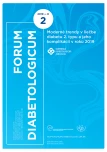Perspectives in the treatment of dyslipoproteinemias in diabetes
Authors:
Ivan Tkáč
Authors‘ workplace:
IV. interná klinika UPJŠ LF a UNLP Košice
Published in:
Forum Diab 2019; 8(2): 80-83
Category:
Review Article
Overview
Hyperlipoproteinemias characterized by elevated LDL cholesterol (LDL-C), triglycerides or lipoprotein(a) have been shown to be pathogenetic risk factors for atherosclerosis. This is based on prospective epidemiological studies of cohorts, as well as recent studies of mendelian randomization.
Treatment to reduce LDL-C levels by using statins, ezitimibe, or PCSK9 inhibitors has led to a reduction in the risk of developing cardiovascular events in the frame of secondary prevention and has been shown to be beneficial in type 2 diabetes because of its significant cardiovascular risk. Treatment increasing HDL-cholesterol (HDL-C) has not been proven to prevent cardiovascular events. New drugs are being developed that can reduce triglycerida and lipoprotein(a) levels more significantly than the currently used lipid-lowering drugs. Their wider use could contribute to a greater reduction in residual cardiovascular risk in diabetic patients in the near future.
Keywords:
LDL-cholesterol – hyperlipidemia – lipoprotein(a) – mendelian randomization – triglycerides
Sources
- Baigent C, Blackwell L, Emberson J et al. [Cholesterol Treatemt Trialists’ (CTT) Collaboration]. Efficacy and safety of more intensive lowering of LDL cholesterol: a meta-analysis of data from 170 000 participants in 26 randomized trials. Lancet 2010; 376(9753): 1670–1681. Dostupné z DOI: <http://dx.doi.org/10.1016/S0140–6736(10)61350–5>.
- Cannon CP, Blazing MA, Giugliano RP et al. [IMPROVE-IT Investigators]. Ezetimibe added to statin therapy after acute coronary syndromes. N Engl J Med 2015; 372(25): 2387–2397. Dostupné z DOI: <http://dx.doi.org/10.1056/NEJMoa1410489>.
- Giugliano RP, Cannon CP, Blazing MA et al. [IMPROVE-IT Investigators]. Benefits of adding ezetimibe to statin therapy on cardiovascular outcomes and safety in patients with versus without diabetes mellitus. Circulation 2018; 137(15): 1571–1582. Dostupné z DOI: <http://dx.doi.org/10.1161/CIRCULATIONAHA.117.030950>.
- Sabatine MS, Giugliano RP, Keech AC et al. [FOURIER Steering Committee and Investigators]. Evelocumab and clinical outcomes in patients with cardiovascular disease. N Engl J Med 2017; 376(18): 1713–1722. Dostupné z DOI: <http://dx.doi.org/10.1056/NEJMoa1615664>.
- Sabatine MS, Leiter LA, Wiviott SD et al. Cardiovascular safety and efficacy of the PCSK9 inhibitor evolocumab in patients with and without diabetes and the effect of evolocumab on glycaemia and risk of new-onset diabetes: a prespecified analysis of the FOURIER randomised contrelled trial. Lancet Diabetes Endocrinol 2017; 5(12): 941–950. <http://dx.doi.org/10.1016/S2213–8587(17)30313–3>.
- Schwartz GG, Steg PG, Szarek M et al. [ODYSSEY OUTCOMES Committees and Investigators]. Alirocumab and cardiovascular outcomes after acute coronary syndrome. N Engl J Med 2018; 379(22): 2097–2107. Dostupné z DOI: <http://dx.doi.org/10.1056/NEJMoa1801174>.
- Voight BF, Peloso GM, Orho-Melander M et al. Plasma HDL cholesterol and risk of myocardial infarction: a mendelian randomisation study. Lancet 2012; 380(9841): 572–580. Dostupné z DOI: <http://dx.doi.org/10.1016/S0140–6736(12)60312–2>. Erratum in Lancet 2012; 380(9841): 564.
- Boden WE, Probstfield JL, Anderson T et al. [AIM-HIGH Investigators]. Niacin in patients with low HDL cholesterol level receiving statin therapy. N Engl J Med 2011; 365(24): 2255–2267. Dostupné z DOI: <http://dx.doi.org/10.1056/NEJMoa1107579>. Erratum in N Engl J Med 2012; 367(2): 18.
- Landray MJ, Haynes R, Hopewell JC et al. [HPS2-THRIVE Collaborative Group]. Effect of extended release niacin with laropiprant in high risk patients. N Engl J Med 2014; 371(3): 203–212. Dostupné z DOI: <http://dx.doi.org/10.1056/NEJMoa1300955>.
- Tall AR, Rader DJ. Trials and tribulations of CETP inhibitors. Circ Res 2018; 122(1): 106–112. Dostupné z DOI: <http://dx.doi.org/10.1161/CIRCRESAHA.117.311978>.
- Sarwar N, Sandhu MS, Ricketts SL et al. [Triglyceride Coronary Disease Genetics Consortium and Emerging Risk Factors Collaboration]. Triglyceride-mediated pathways and coronary disease: collaborative analysis of 101 studies. Lancet 2010; 375(9726): 1634–1639. Dostupné z DOI: <http://dx.doi.org/10.1016/S0140–6736(10)60545–4>. Erratum in Lancet 2010; 376(9735): 90. Kastelein JJ [added].
- Ference BA, Kastelein JJ, Ray KK et al. Association of triglyceride-lowering LPL variants and LDL-C-lowering LDLR variants with risk of coronary artery disease. JAMA 2019; 321(4): 364–373. Dostupné z DOI: <http://dx.doi.org/10.1001/jama.2018.20045>.
- Ginsberg HN, Elam MB, Lovato LC et al. [ACCORD Study Group]. Effects of combination lipid therapy in type 2 diabetes mellitus. N Engl J Med 2010; 362(17): 1563–1574. Dostupné z DOI: <http://dx.doi.org/10.1056/NEJMoa1001282>. Erratum in N Engl J Med 2010; 362(18): 1748.
- Keech A, Simes RJ, Barter P et al. [FIELD Study Investigators]. Effects of long-term fenofibrate therapy on cardiovascular events in 9795 people with type 2 diabetes mellitus (the FIELD study): randomised controlled trial. Lancet 2005; 366(9500): 1849–1861. Dostupné z DOI: <http://dx.doi.org/10.1016/S0140–6736(05)67667–2>. Erratum in Correction to the FIELD study report. [Lancet 2006]. Lancet 2006; 368(9545): 1420.
- Bhatt DL, Steg PG, Miller M et al. [REDUCE-IT Investigators]. Cardiovascular risk reduction with icosapent ethyl for hypertriglyceridemia. N Engl J Med 2019; 380(1): 11–20. Dostupné z DOI: <http://dx.doi.org/10.1056/NEJMoa1812792>.
- Kastelein JJ, Stroes ES. FISHing for the miracle of eicosapentaenoic acid. N Engl J Med 2019; 380(1): 89–90. Dostupné z DOI: <http://dx.doi.org/10.1056/NEJMe1814004>.
- Graham MJ, Lee RG, Brandt TA et al. Cardiovascular and metabolic effects of ABGPTL3 antisense oligonucleotides. N Engl J Med 2017; 377(3): 222–232. Dostupné z DOI: <http://dx.doi.org/10.1056/NEJMoa1701329>.
- Nordestagaard BG, Langsted A. Lipoprotein (a) as a cause of cardiovascular disease: insights from epidemiology, genetics and biology. J Lipid Res 2016; 57(11): 1953–1975. Dostupné z DOI: <http://dx.doi.org/10.1194/jlr.R071233>.
- Burgess S, Ference BA, Staley JR et al [European Prospective Investigation Into Cancer and Nutrition-Cardiovascular Disease (EPIC-CVD) Consortium]. Association of LPA variants with risk of coronary disease and the implications for Lipoprotein(a)-lowering therapies. A mendelian randomization analysis. JAMA Cardiol 2018; 3(7): 619–627. Dostupné z DOI: <http://dx.doi.org/10.1001/jamacardio.2018.1470>.
- Tsimikas S. Safety and efficacy of AKCEA-APO(a)-LRx to lower lipoprotein(a) in patients with established cardiovascular disease: A phase 2 dose-ranging trial. PRESENTATION AHA (AMERICAN HEART ASSOCIATION) 2018. Prezentované na Kongrese AHA 2018. https://pace-cme.org/2018/11/11/.
Labels
Diabetology Endocrinology Internal medicineArticle was published in
Forum Diabetologicum

2019 Issue 2
Most read in this issue
- Modern trends in the treatment of hypertension
- Updates in obesity pharmacotherapy
- Modern trends in local treatment of diabetic foot
- Insulin pump treatment in type 1 diabetes mellitus – for whom and why?
